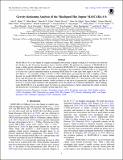Gravity-darkening Analysis of the Misaligned Hot Jupiter MASCARA-4 b
Author(s)
Ahlers, John P.; Kruse, Ethan; Colón, Knicole D.; Dorval, Patrick; Talens, Geert Jan; Snellen, Ignas; Albrecht, Simon; Otten, Gilles; Ricker, George; Vanderspek, Roland; Latham, David; Seager, Sara; Winn, Joshua; Jenkins, Jon M.; Haworth, Kari; Cartwright, Scott; Morris, Robert; Rowden, Pam; Tenenbaum, Peter; Ting, Eric B.; ... Show more Show less
DownloadPublished version (1.102Mb)
Publisher Policy
Publisher Policy
Article is made available in accordance with the publisher's policy and may be subject to US copyright law. Please refer to the publisher's site for terms of use.
Terms of use
Metadata
Show full item recordAbstract
MASCARA-4 b is a hot Jupiter in a highly misaligned orbit around a rapidly rotating A3V star that was observed for 54 days by the Transiting Exoplanet Survey Satellite (TESS). We perform two analyses of MASCARA-4 b using a stellar gravity-darkened model. First, we measure MASCARA-4 b's misaligned orbital configuration by modeling its TESS photometric light curve. We take advantage of the asymmetry in MASCARA-4 b's transit due to its host star's gravity-darkened surface to measure MASCARA-4 b's true spin-orbit angle to be 104°[superscript +7°][subscript -13°]. We also detect a ∼4σ secondary eclipse at 0.491 ± 0.007 orbital phase, proving that the orbit is slightly eccentric. Second, we model MASCARA-4 b's insolation including gravity darkening and find that the planet's received X-ray and ultraviolet flux varies by 4% throughout its orbit. MASCARA-4 b's short-period, polar orbit suggests that the planet likely underwent dramatic orbital evolution to end up in its present-day configuration and that it receives a varying stellar irradiance that perpetually forces the planet out of thermal equilibrium. These findings make MASCARA-4 b an excellent target for follow-up characterization to better understand the orbital evolution and present-day environment of planets around high-mass stars.
Date issued
2020-01Department
Massachusetts Institute of Technology. Department of Earth, Atmospheric, and Planetary Sciences; Massachusetts Institute of Technology. Department of Physics; Massachusetts Institute of Technology. Department of Aeronautics and Astronautics; MIT Kavli Institute for Astrophysics and Space ResearchJournal
Astrophysical Journal
Publisher
American Astronomical Society
Citation
Ahlers, John P., et al. “Gravity-Darkening Analysis of the Misaligned Hot Jupiter MASCARA-4 b.” The Astrophysical Journal 888, 2 (January 2020): 63. © 2020 The American Astronomical Society
Version: Final published version
ISSN
1538-4357